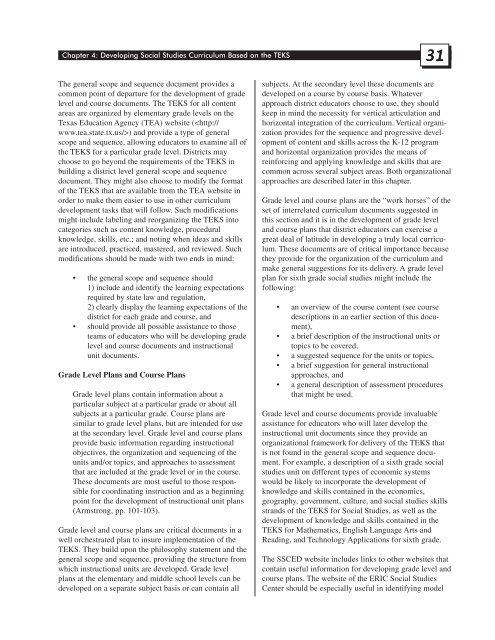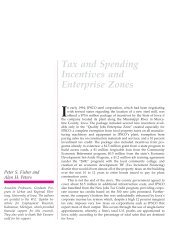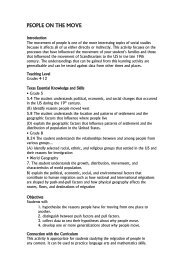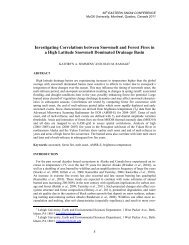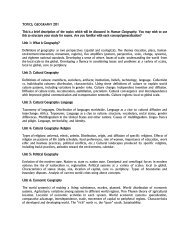Texas Social Studies Framework - Department of Geography ...
Texas Social Studies Framework - Department of Geography ...
Texas Social Studies Framework - Department of Geography ...
You also want an ePaper? Increase the reach of your titles
YUMPU automatically turns print PDFs into web optimized ePapers that Google loves.
Chapter 4: Developing <strong>Social</strong> <strong>Studies</strong> Curriculum Based on the TEKS<br />
The general scope and sequence document provides a<br />
common point <strong>of</strong> departure for the development <strong>of</strong> grade<br />
level and course documents. The TEKS for all content<br />
areas are organized by elementary grade levels on the<br />
<strong>Texas</strong> Education Agency (TEA) website () and provide a type <strong>of</strong> general<br />
scope and sequence, allowing educators to examine all <strong>of</strong><br />
the TEKS for a particular grade level. Districts may<br />
choose to go beyond the requirements <strong>of</strong> the TEKS in<br />
building a district level general scope and sequence<br />
document. They might also choose to modify the format<br />
<strong>of</strong> the TEKS that are available from the TEA website in<br />
order to make them easier to use in other curriculum<br />
development tasks that will follow. Such modifications<br />
might include labeling and reorganizing the TEKS into<br />
categories such as content knowledge, procedural<br />
knowledge, skills, etc.; and noting when ideas and skills<br />
are introduced, practiced, mastered, and reviewed. Such<br />
modifications should be made with two ends in mind:<br />
• the general scope and sequence should<br />
1) include and identify the learning expectations<br />
required by state law and regulation,<br />
2) clearly display the learning expectations <strong>of</strong> the<br />
district for each grade and course, and<br />
• should provide all possible assistance to those<br />
teams <strong>of</strong> educators who will be developing grade<br />
level and course documents and instructional<br />
unit documents.<br />
Grade Level Plans and Course Plans<br />
Grade level plans contain information about a<br />
particular subject at a particular grade or about all<br />
subjects at a particular grade. Course plans are<br />
similar to grade level plans, but are intended for use<br />
at the secondary level. Grade level and course plans<br />
provide basic information regarding instructional<br />
objectives, the organization and sequencing <strong>of</strong> the<br />
units and/or topics, and approaches to assessment<br />
that are included at the grade level or in the course.<br />
These documents are most useful to those responsible<br />
for coordinating instruction and as a beginning<br />
point for the development <strong>of</strong> instructional unit plans<br />
(Armstrong, pp. 101-103).<br />
Grade level and course plans are critical documents in a<br />
well orchestrated plan to insure implementation <strong>of</strong> the<br />
TEKS. They build upon the philosophy statement and the<br />
general scope and sequence, providing the structure from<br />
which instructional units are developed. Grade level<br />
plans at the elementary and middle school levels can be<br />
developed on a separate subject basis or can contain all<br />
31<br />
31<br />
subjects. At the secondary level these documents are<br />
developed on a course by course basis. Whatever<br />
approach district educators choose to use, they should<br />
keep in mind the necessity for vertical articulation and<br />
horizontal integration <strong>of</strong> the curriculum. Vertical organization<br />
provides for the sequence and progressive development<br />
<strong>of</strong> content and skills across the K-12 program<br />
and horizontal organization provides the means <strong>of</strong><br />
reinforcing and applying knowledge and skills that are<br />
common across several subject areas. Both organizational<br />
approaches are described later in this chapter.<br />
Grade level and course plans are the “work horses” <strong>of</strong> the<br />
set <strong>of</strong> interrelated curriculum documents suggested in<br />
this section and it is in the development <strong>of</strong> grade level<br />
and course plans that district educators can exercise a<br />
great deal <strong>of</strong> latitude in developing a truly local curriculum.<br />
These documents are <strong>of</strong> critical importance because<br />
they provide for the organization <strong>of</strong> the curriculum and<br />
make general suggestions for its delivery. A grade level<br />
plan for sixth grade social studies might include the<br />
following:<br />
• an overview <strong>of</strong> the course content (see course<br />
descriptions in an earlier section <strong>of</strong> this document),<br />
• a brief description <strong>of</strong> the instructional units or<br />
topics to be covered,<br />
• a suggested sequence for the units or topics,<br />
• a brief suggestion for general instructional<br />
approaches, and<br />
• a general description <strong>of</strong> assessment procedures<br />
that might be used.<br />
Grade level and course documents provide invaluable<br />
assistance for educators who will later develop the<br />
instructional unit documents since they provide an<br />
organizational framework for delivery <strong>of</strong> the TEKS that<br />
is not found in the general scope and sequence document.<br />
For example, a description <strong>of</strong> a sixth grade social<br />
studies unit on different types <strong>of</strong> economic systems<br />
would be likely to incorporate the development <strong>of</strong><br />
knowledge and skills contained in the economics,<br />
geography, government, culture, and social studies skills<br />
strands <strong>of</strong> the TEKS for <strong>Social</strong> <strong>Studies</strong>, as well as the<br />
development <strong>of</strong> knowledge and skills contained in the<br />
TEKS for Mathematics, English Language Arts and<br />
Reading, and Technology Applications for sixth grade.<br />
The SSCED website includes links to other websites that<br />
contain useful information for developing grade level and<br />
course plans. The website <strong>of</strong> the ERIC <strong>Social</strong> <strong>Studies</strong><br />
Center should be especially useful in identifying model


